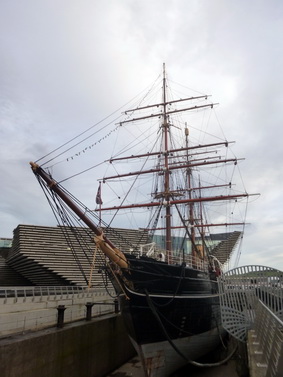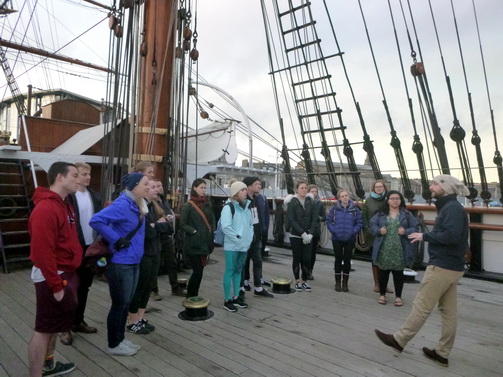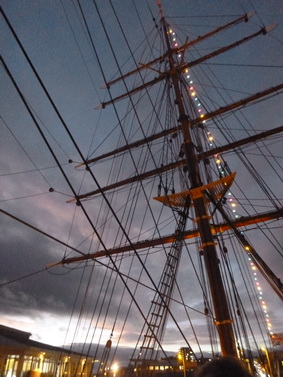A piece of Antarctica in Scotland

Even though our direction was northward bound (from St Andrews), our visit to the RRS Discovery in Dundee felt like a step closer to Antarctica.
When the masts of the ship appeared on the horizon lyrics from “Dr. Livingstone I presume” by the Moody Blues popped into my head:
Captain Scott, you were so bold,
Now you’re looking rather cold,
Out there in the snow.
What did you find there?
Did you stand awhile and stare?
Did you meet anyone?
Captain Robert Falcon Scott was the first to lead the Discovery on a research expedition to Antarctica. Sadly, he passed away in 1912 during his second expedition to Antarctica, so our captain for exploring the RRS Discovery was Ali from Dundee Heritage. He took us along a wonderful tour around this 117 year (!) old vessel.

The Discovery was launched in 1901 and was the first British ship to be built with a scientific purpose. When the ship and the crew arrived in Antarctica in 1902 that was only the beginning of their adventures, because the vessel got stuck in the ice for 2 years! In the end two relief ships, saws and explosives freed her from the cold grip of the sea ice. Once she and the crew returned to UK the expedition costs had exploded and had to be paid. As a result the Discovery was sold. She then made many more journeys including to the Falkland Islands and Antarctica, but over time was refitted to serve as a training ship for the Sea Cadet Corps in Britain. Eventually she was retired and found a home at the RRS Discovery centre where we could admire her today.

Ali also told us many stories about the life of the crew on board the ship during the first expedition to Antarctica. For example, there were two toilets on deck. One was for the 12 officers and the other toilet was for the 36 crew members! The crew worked four hour shifts and shared hammocks accordingly (hot bunking). They also had to take one bath a week. Literally one bath for 36 people that is. You can imagine that you did not want to be the last person who entered that tub…..

Everyone on the ship received three cooked meals a day. Although the ship could store food for three years, the crew started to experience a shortage of fresh food when they were in Antarctica. Therefore, penguin and seal became part of the menu. Without realising it, this meat might have actually saved lives, because it contained vitamin C and prevented the man from getting scurvy. The amount of penguins and seals that were sacrificed was estimated at 500 in total.

Besides from people there were also several animals on board. It started with a flock of sheep, a pack of huskies (the sledge dogs) and two cats to get rid of the rats. Later on two weakened Emperor penguins were taken aboard in a (failed) attempt to rescue them.

Although Captain Scott and later on Shackleton became famous by name, our historic role models of the first Antarctica expedition was probably physician and biologist Reginald Koettlitz. For example, he collected all types of rock, grew the first crops on Antarctic soil and had his own dark room to develop photographs. Of course there was also the later so famous Edward Wilson, zoologist and artist who drew many excellent portraits of Antarctica’s natural inhabitants. This early polar research and other findings during the many expeditions with the Discovery eventually helped to contribute to the conservation of the Antarctic ecosystem today.

Our tour ended outside on the deck of the Discovery. It had already got ten dark and the wind was chilly. When I closed my eyes I could almost image myself in the Antarctic. Our visit to the Discovery centre made history come to life. Where first things seemed unreal our expedition now became more tangible. If we feel like complaining about the cold and harsh conditions while we are on the Plancius in March we only need to think back of our visit to the Discovery and remember that we are privileged to travel to Antarctica in luxury (and in heated cabins with en-suite toilets!).
ten dark and the wind was chilly. When I closed my eyes I could almost image myself in the Antarctic. Our visit to the Discovery centre made history come to life. Where first things seemed unreal our expedition now became more tangible. If we feel like complaining about the cold and harsh conditions while we are on the Plancius in March we only need to think back of our visit to the Discovery and remember that we are privileged to travel to Antarctica in luxury (and in heated cabins with en-suite toilets!).
written by Nathalie Houtman
